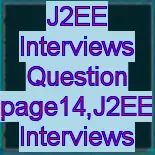J2EE Interviews Question page14
- What is North American Industry Classification System (NAICS) ?
A system for classifying business establishments based on the processes they use to produce goods or services.
-
What is notation ?
A mechanism for defining a data format for a non-XML document referenced as an unparsed entity. This is a holdover from SGML. A newer standard is to use MIME data types and namespaces to prevent naming conflicts.
-
What is OASIS ?
Organization for the Advancement of Structured Information Standards. A consortium that drives the development, convergence, and adoption of e-business standards.
-
What is OMG ?
Object Management Group. A consortium that produces and maintains computer industry specifications for interoperable enterprise applications.
-
What is one-way messaging ?
A method of transmitting messages without having to block until a response is received.
-
What is ORB ?
Object request broker. A library that enables CORBA objects to locate and communicate with one another.
-
What is OS principal ?
A principal native to the operating system on which the J2EE platform is executing.
-
What is OTS ?
Object Transaction Service. A definition of the interfaces that permit CORBA objects to participate in transactions.
-
What is parameter entity ?
An entity that consists of DTD specifications, as distinct from a general entity. A parameter entity defined in the DTD can then be referenced at other points, thereby eliminating the need to recode the definition at each location it is used.
-
What is parsed entity ?
A general entity that contains XML and therefore is parsed when inserted into the XML document, as opposed to an unparsed entity.
-
What is parser ?
A module that reads in XML data from an input source and breaks it into chunks so that your program knows when it is working with a tag, an attribute, or element data. A nonvalidating parser ensures that the XML data is well formed but does not verify that it is valid. See also validating parser.
-
What is passivation ?
The process of transferring an enterprise bean from memory to secondary storage. See activation.
-
What is persistence ?
The protocol for transferring the state of an entity bean between its instance variables and an underlying database.
-
What is persistent field ?
A virtual field of an entity bean that has container-managed persistence; it is stored in a database.
-
What is POA ?
Portable Object Adapter. A CORBA standard for building server-side applications that are portable across heterogeneous ORBs.
-
What is point-to-point messaging system ?
A messaging system built on the concept of message queues. Each message is addressed to a specific queue; clients extract messages from the queues established to hold their messages.
-
What is primary key ?
An object that uniquely identifies an entity bean within a home.
-
What is principal ?
The identity assigned to a user as a result of authentication.
-
What is privilege ?
A security attribute that does not have the property of uniqueness and that can be shared by many principals.
-
What is processing instruction ?
Information contained in an XML structure that is intended to be interpreted by a specific application.
-
What is programmatic security ?
Security decisions that are made by security-aware applications. Programmatic security is useful when declarative security alone is not sufficient to express the security model of an application.
-
What is prolog ?
The part of an XML document that precedes the XML data. The prolog includes the declaration and an optional DTD.
-
What is public key certificate ?
Used in client-certificate authentication to enable the server, and optionally the client, to authenticate each other. The public key certificate is the digital equivalent of a passport. It is issued by a trusted organization, called a certificate authority, and provides identification for the bearer.
-
What is publish/subscribe messaging system ?
A messaging system in which clients address messages to a specific node in a content hierarchy, called a topic. Publishers and subscribers are generally anonymous and can dynamically publish or subscribe to the content hierarchy. The system takes care of distributing the messages arriving from a node's multiple publishers to its multiple subscribers.



